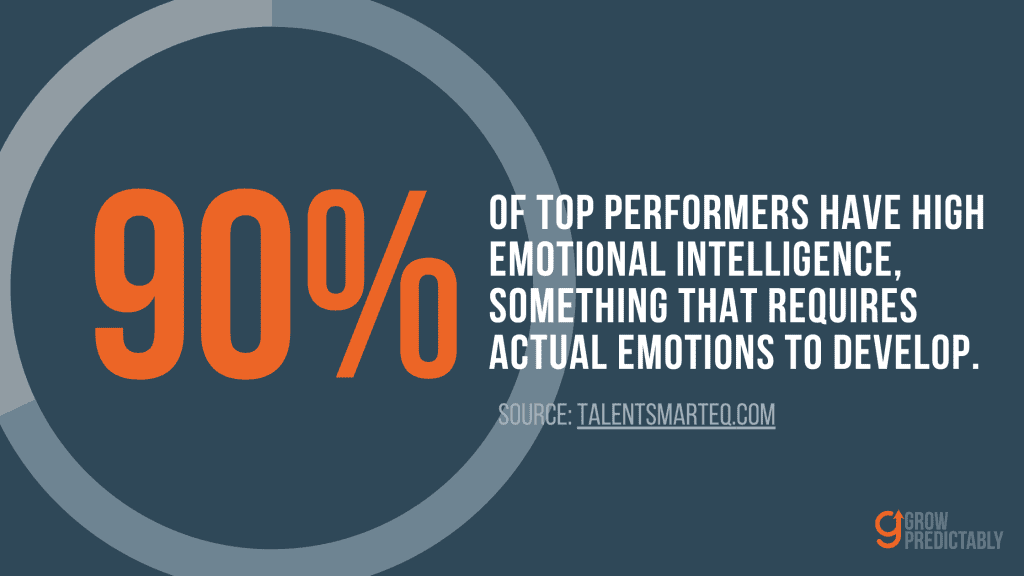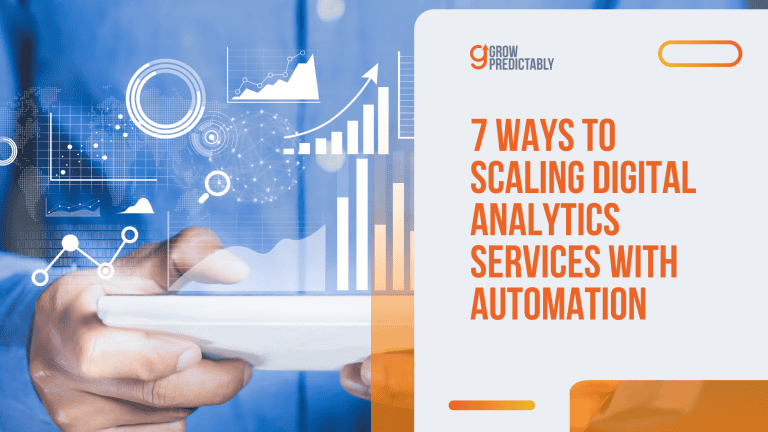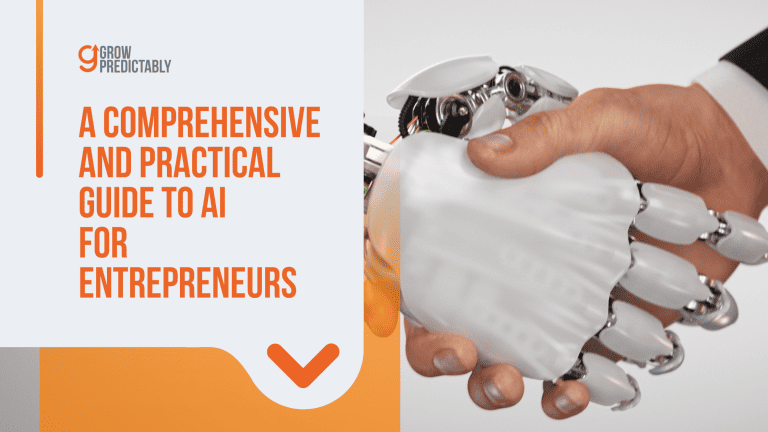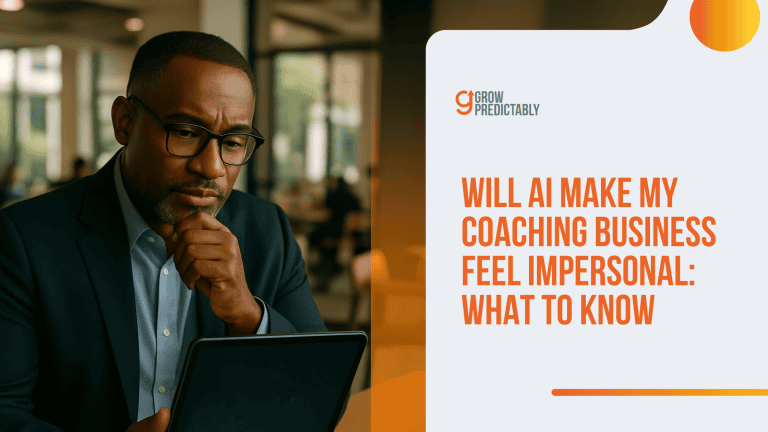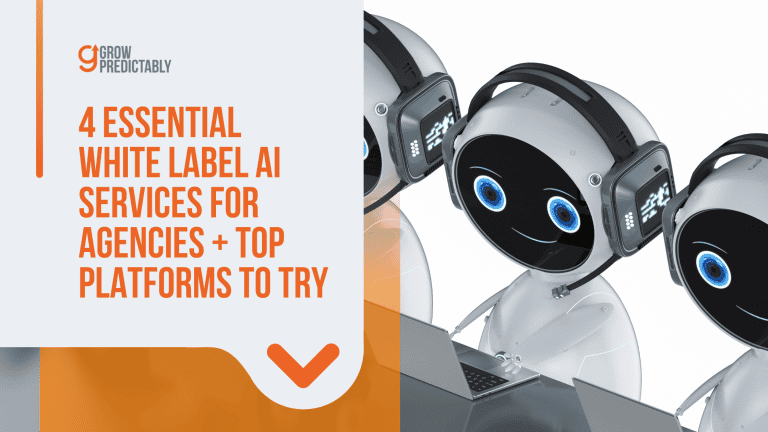7 AI Creativity Myths for Thought Leaders You Need to Stop Believing
75% of executives believe AI will transform their industry, yet myths still hold teams back.
Many thought leaders avoid AI in their creative work—afraid it will water down their unique voice, replace human thinking, or churn out cookie-cutter content that hurts their reputation. These AI creativity myths for thought leaders aren’t just wrong; they’re costing you speed and reach while others move ahead.
The truth is straightforward: AI doesn’t steal creativity—it boosts it. When you see past these myths and grasp what AI actually does, you gain faster ideas, clearer thinking, and content that grows without losing your edge.
Grow Predictably’s approach cuts through the noise, showing exactly where your judgment counts and where AI does the heavy lifting.
Let’s expose what’s fiction and what actually works.
TL;DR
Thought leaders often believe myths about AI, fearing it will replace creativity, empathy, and expertise. In reality, AI should be viewed as a tool that amplifies their unique human skills, enabling them to focus on strategic and creative tasks rather than routine ones.
KEY TAKEAWAYS
- Use AI to handle routine tasks, freeing up time for strategic decision-making and client relationship building.
- Focus on leveraging AI for insights and efficiency rather than fearing it will replace human creativity or expertise.
- Embrace AI as a complement to your work, enhancing your professional value and allowing for more impactful client interactions.
How AI Operates
To make the most of artificial intelligence (AI) in your business, it’s essential to understand how these systems actually work.
At their core, AI tools process massive amounts of data, recognize patterns, and make predictions based on that information.
Whether it’s a large language model generating marketing copy or a recommendation engine analyzing customer behavior, artificial intelligence operates through algorithms trained on diverse data sources.
But here’s the reality check: AI lacks true creativity, emotional intelligence, and self-awareness.
While AI systems can mimic human-like responses and automate repetitive tasks, they don’t possess the intuition or strategic thinking that comes from lived experience.
Instead, AI frees humans from routine work, allowing you to focus on higher-level problem solving, decision making, and creative expression.
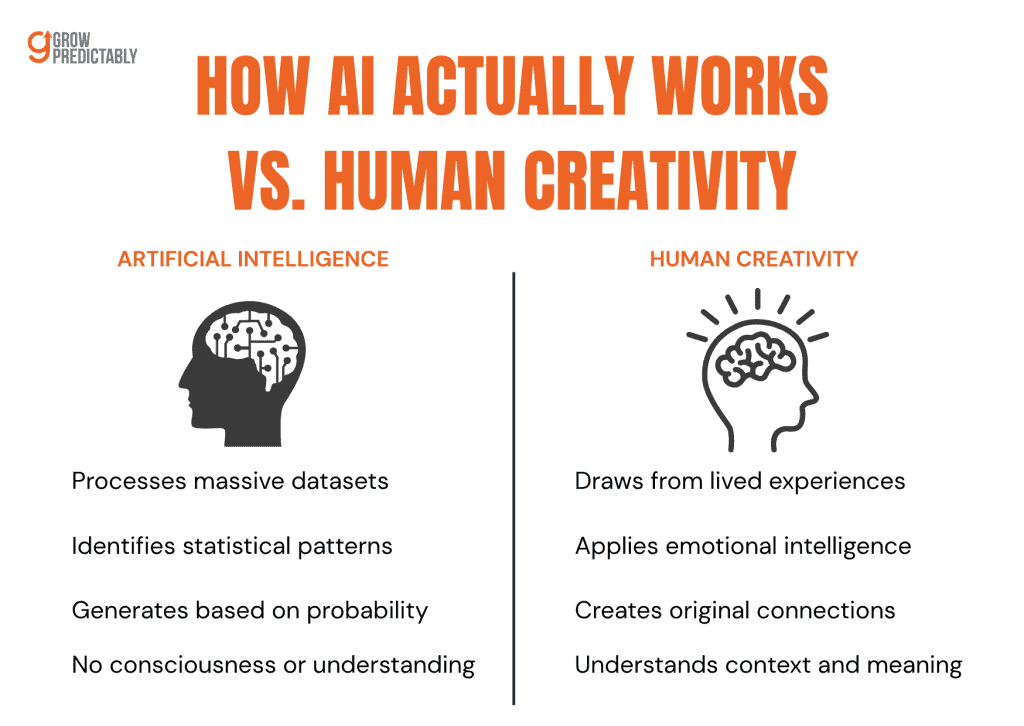
Think of AI as a powerful tool that augments your capabilities.
It can analyze trends, organize information, and suggest ideas at lightning speed, but it relies on human oversight to ensure relevance, accuracy, and impact.
It is also crucial to verify the truth of AI outputs, as artificial intelligence does not inherently guarantee factual accuracy.
By understanding how AI operates—and where its limitations lie—you can use it to drive innovation, improve efficiency, and gain deeper insights into your customers and markets.
Recognizing the true potential of AI allows you to combine human expertise with artificial intelligence, maximizing value and results.
The real value comes from combining the strengths of both humans and AI, pushing boundaries and transforming the way you work.
Myth 1: AI Will Replace Human Creativity
Coaches and consultants sell their thinking.
When AI starts writing copy and creating strategies, panic sets in.
The fear makes sense – if a machine can do what you charge for, where does that leave you?
Many worry that AI will take all our jobs, but this is a myth that creates unnecessary anxiety among business leaders and teams.
In reality, accessible AI solutions are designed to support and enhance human creativity, not replace it, making advanced technology practical and customizable for organizations of all sizes.
This myth spreads because most people only see AI’s surface capabilities.
They watch ChatGPT write a decent blog post and assume it can replace years of client experience.
What they miss is the difference between generating content and actually solving problems.
Smart leaders use AI to make human creativity stronger and spark creativity by providing new perspectives and ideas.
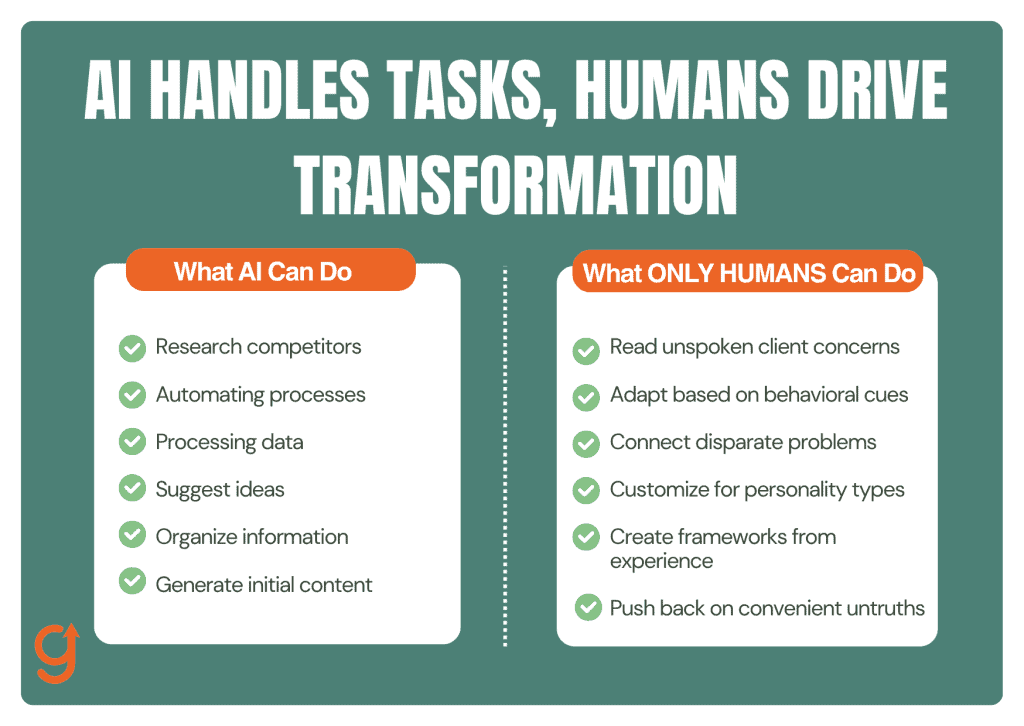
AI handles tasks, not transformation
AI excels at specific tasks but fails at the complex work that builds real businesses.
It can research competitors, draft outlines, and suggest ideas.
But it cannot understand your client’s unspoken concerns, read between the lines in a conversation, or adapt a framework based on subtle behavioral cues.
Your creativity comes from pattern recognition across hundreds of client interactions. AI learns from text data – you learn from human behavior.
When a client says “yes” but their body language screams “no,” you adjust.
AI keeps following its script.
Think about what actually happens in your best client sessions:
- You notice energy shifts when discussing certain topics
- You connect seemingly unrelated problems to find root causes
- You customize advice based on the client’s personality and communication style
- You push back when clients give convenient but untrue answers
- You create frameworks that match how their specific brain works
AI cannot replicate this intuitive problem-solving.
Unlike humans, AI cannot generate original thought; it can only remix existing ideas, while true human creativity is rooted in unique, personally inspired insights.
Research from MIT shows that human creativity involves connecting disparate concepts in ways that AI struggles to match, especially when context and emotional intelligence matter.
The brainstorming example that changes everything
Here’s how this plays out practically.
You can ask AI to brainstorm marketing angles for a new course launch.
It might suggest content calendars, email sequences, and social media hooks.
Useful stuff, but generic.
Now compare that to creating a custom client framework.
You take everything you know about their industry, personality, past failures, and specific goals.
You design something that fits their exact situation.
The framework reflects their language, addresses their unique blindspots, and builds on their existing strengths.
AI helps with the brainstorming phase – generating options and organizing thoughts. While AI can assist in generating options, the core idea and its refinement still come from human expertise.
But the framework creation requires human insight that no algorithm possesses.
You’re not just combining information; you’re solving a specific human puzzle that requires intuition, experience, and genuine understanding of what drives behavior change.
Smart thought leaders use AI for research and ideation, then apply their expertise to create something genuinely valuable.
The combination makes you more effective, not replaceable.
Myth 2: AI Can “Think” or “Feel” Like a Human
AI doesn’t think – it predicts.
The idea that “AI thinks” is a misconception; AI does not possess genuine thought.
When ChatGPT responds to your question, it’s calculating which words most likely come next based on patterns in training data.
No consciousness, no understanding, just very sophisticated pattern matching.
The belief that “ai understands” is also a myth—AI only mimics understanding through pattern recognition, not true comprehension.
This matters because clients don’t pay you to predict words.
They pay you to understand their situation and care about their outcome.
AI can mimic empathy by using the right phrases, but it has zero emotional investment in whether your client succeeds or fails.
The confusion happens because AI responses sound human.
The writing flows naturally and addresses your concerns.
But underneath, there’s no actual comprehension of what those words mean or why they matter to you personally.
Your emotional intelligence creates real breakthroughs
Emotions drive every business decision, even when people pretend they’re being logical.
Your ability to read frustration, excitement, fear, and resistance in real-time gives you information that no AI system can access.
When a client says their team “lacks motivation,” you hear the disappointment in their voice.
You notice they avoid eye contact when discussing certain team members.
You pick up on the guilt they feel about their leadership style.
This emotional data helps you identify the real problem and craft solutions that actually work.
Your lived experience adds another layer AI cannot replicate.
You’ve been through business failures, difficult conversations, and personal struggles that inform how you guide others.
When you tell a client “I understand what you’re going through,” you mean it literally – because you have the scars to prove it.
Consider these uniquely human capabilities that drive results:
- Reading micro-expressions during difficult conversations
- Knowing when to push harder versus when to back off
- Sharing personal stories that create genuine connection
- Feeling genuinely excited when clients achieve breakthroughs
- Adapting your approach based on someone’s emotional state
- Building trust through authentic vulnerability
Why AI empathy feels hollow
AI can generate empathetic responses that sound convincing on the surface.
It might say “I understand how frustrating that must be” or “That sounds really challenging.”
The words are right, but the emotional foundation is missing.
Real empathy requires you to actually feel something when someone shares their pain.
When a client talks about their failing business, you feel genuine concern for their family, their employees, and their future.
That emotional connection drives you to dig deeper, ask better questions, and push for real solutions.
AI empathy is performative – designed to make interactions feel human without any genuine emotional investment.
It’s like watching a movie where the actor says all the right lines but you can tell they don’t mean it.
The words are there, but the heart isn’t.
Your clients can sense this difference immediately.
They know when someone truly cares about their success versus when someone is just going through the motions.
That authentic connection becomes the foundation for trust, honesty, and ultimately, transformation.
The smartest approach is letting AI handle information processing while you focus on the human elements that actually create change.
AI researches their industry and suggests strategies.
You understand their fears and help them overcome the internal barriers that keep them stuck.
Myth 3: Using AI Is “Cheating” or Makes Your Work Less Original
Coaches and consultants worry that using AI tools somehow diminishes their credibility.
Learning to use AI effectively is a new skill that enhances your professional value, showing adaptability to changing technologies.
They fear clients will discover they used ChatGPT to draft an email or research a topic, then question whether they’re getting “real” expertise.
This guilt comes from misunderstanding what makes work original.
Your value doesn’t come from typing every word yourself – it comes from your judgment, experience, and ability to synthesize information into actionable insights.
Using AI doesn’t make you a fraud any more than using a calculator makes you bad at math.
The perception problem is real but overblown.
Most clients care about results, not process.
They want solutions that work, frameworks that fit their situation, and guidance that moves them forward.
Whether you used AI to research their industry or brainstorm initial ideas matters far less than whether your advice actually helps them succeed.
Your creative voice remains untouched
Think of AI as a sophisticated research assistant, not a creative replacement.
When architects use CAD software instead of drawing blueprints by hand, the building is still their design.
The tool handles technical execution while the architect provides vision, creativity, and expertise.
Your creative voice encompasses your unique perspective, communication style, and approach to problem-solving.
These elements emerge from years of experience working with clients, not from how you organize information or draft initial content.
AI can help you research faster and organize thoughts more efficiently, but it cannot replicate your specific worldview or methodology.
The originality comes from what you do with the information, not where it originates.
You take AI-generated research and filter it through your experience.
You spot patterns the AI missed.
You know which strategies work for different personality types.
You customize generic advice based on specific client needs.
Consider what actually makes your work original:
- Your unique methodology developed through client successes and failures
- Personal stories and examples from your journey
- Specific frameworks tailored to your niche and audience
- The way you connect disparate concepts into cohesive strategies
- Your ability to spot what won’t work before clients waste time and money
- The questions you ask that others miss
These elements remain completely yours, regardless of which tools you use to support your thinking process.
You still own every decision
Using AI tools doesn’t transfer authorship to the machine.
You decide which AI suggestions to use, modify, or ignore completely.
You choose how to frame concepts, which examples to include, and what tone to adopt.
Every piece of content still reflects your judgment and expertise.
When you use AI to draft a client assessment, you’re not surrendering control – you’re accelerating the initial phase so you can spend more time on analysis and customization.
The AI might suggest twenty potential issues; you select the three that actually matter for this specific situation.
The AI provides raw material; you craft the solution.
Research indicates that 73% of business executives believe AI enhances rather than replaces human decision-making, particularly in creative and strategic work.
The tool amplifies your capabilities without diminishing your contribution.
Your authorship shows up in the choices you make throughout the process.
Which research angles to pursue, how to structure the final framework, what examples resonate with your audience, and how to present complex ideas simply.
These decisions require human judgment that no AI possesses.
The smartest thought leaders treat AI like any other professional tool – valuable for specific tasks but never a substitute for expertise, judgment, and genuine human insight.
Your work remains original because your thinking remains your own.
Myth 4: “If It’s AI-Generated, It Must Be Completely New (or Always Unoriginal)”
Generating art is another notable example of AI’s creative applications, alongside writing and strategy generation.
AI doesn’t create from nothing – it remixes existing patterns in ways that feel new.
When you ask ChatGPT to write a marketing strategy, it combines elements from thousands of strategies it learned during training.
The result might surprise you, but every component came from somewhere else.
This creates two opposite but equally wrong assumptions.
Some people think AI output is groundbreaking because they haven’t seen that exact combination before.
Others dismiss it as worthless copying because nothing is truly original.
Both miss how creativity actually works in the real world.
Even human creativity builds on existing ideas.
Your best frameworks probably combine concepts from different mentors, books, and client experiences.
The value comes from how you blend these influences, not from inventing something that never existed before.
Pattern recognition versus human insight
AI excels at finding patterns across massive datasets that would take humans years to analyze.
It can identify which email subject lines perform best, what content structures engage audiences, or how successful coaches position their services.
This pattern recognition is genuinely useful.
But patterns don’t equal understanding.
AI might notice that vulnerability-based content gets more engagement without grasping why emotional honesty creates connection.
It sees the what without understanding the why – and the why is where your expertise becomes invaluable.
Your human insight transforms AI patterns into something meaningful.
You know that vulnerability works because people crave authentic connection in a world full of polished facades.
You understand when to be vulnerable versus when to project confidence.
You can adapt the pattern based on your audience’s specific needs and cultural context.
This combination creates something more valuable than either AI or human thinking alone:
- AI identifies patterns you might miss across large datasets
- You understand the human psychology behind why patterns work
- AI suggests structural approaches and organizational frameworks
- You customize the content based on your audience’s specific challenges
- AI provides initial research and competitive analysis
- You synthesize insights with your experience to create actionable strategies
The magic happens in the intersection between AI’s pattern recognition and your contextual understanding.
Draft, refine, and personalize
Smart thought leaders use AI as their first draft generator, not their final answer.
The AI provides a starting point based on successful patterns, then you layer in the elements that make the work genuinely yours.
Start with an AI-generated outline for a client presentation.
The structure might be solid – problem identification, solution framework, implementation steps.
But the outline lacks the personal touches that make presentations memorable and persuasive.
You add your signature stories that illustrate key points.
You include specific examples from your client work that demonstrate real results.
You adjust the language to match how you naturally speak.
You anticipate objections based on similar conversations you’ve had before.
The final presentation contains AI elements, but it sounds like you and addresses your audience’s specific concerns.
Nobody could have generated this exact combination except you, because it required your personal experience and judgment to create.
Studies show that content combining AI efficiency with human creativity performs 40% better than purely AI-generated material in terms of audience engagement and business results.
Your personal stories become the differentiating factor that transforms generic advice into compelling guidance.
When you share how you overcame a specific challenge or learned from a particular failure, you’re adding something no AI can replicate – authentic human experience that creates trust and connection.
The most effective approach treats AI as your research assistant and first-draft writer, while you handle the strategy, personalization, and human elements that actually drive results.
The combination leverages the best of both worlds without surrendering what makes your work uniquely valuable.
Myth 5: AI Can Work on Its Own (You Don’t Need to Guide or Edit It)
Too many thought leaders treat AI like a seasoned expert who can handle complex work independently.
They paste in a vague prompt, copy the output directly into their content, and wonder why the results feel generic or miss the mark completely.
AI works more like a talented but inexperienced intern. It can handle specific tasks quickly and efficiently, but it needs clear direction, constant feedback, and careful supervision.
Without guidance, it produces work that’s technically correct but strategically worthless.
The temptation to let AI run unsupervised is strong because the initial results often look impressive. This approach is often driven by unrealistic expectations about AI’s capabilities, which can lead to disappointment and poor outcomes.
The writing flows well, the structure makes sense, and it saves enormous amounts of time.
But scratch beneath the surface and you’ll find gaps in logic, generic advice, and content that doesn’t match your brand voice or client needs.
Your oversight determines the quality
AI has no quality standards beyond generating text that sounds plausible.
It doesn’t know whether its suggestions will actually work for your specific audience, align with your methodology, or reflect current market conditions.
That judgment comes entirely from you.
Every AI output needs human review for accuracy, relevance, and strategic fit.
You catch factual errors, outdated information, and advice that contradicts your experience.
You spot when the tone doesn’t match your brand or when suggestions would confuse rather than help your audience.
The editing process is where the real value gets created.
You strengthen weak arguments, add supporting evidence, and ensure the content flows logically from problem to solution.
You remove generic advice and replace it with specific, actionable steps that reflect your methodology.
Your curation responsibilities include several critical areas:
- Fact-checking statistics and claims for accuracy and currency
- Ensuring recommendations align with your proven methodologies
- Adjusting tone and language to match your authentic voice
- Removing generic advice that doesn’t serve your specific audience
- Adding relevant examples and case studies from your experience
- Checking that content supports your overall strategic goals
Without this oversight, AI output often sounds professional but delivers little actual value to your audience.
The client presentation disaster waiting to happen
Picture this scenario: You’re preparing a strategy presentation for a high-value client.
Pressed for time, you feed AI their company information and ask for a growth strategy.
The output looks comprehensive – detailed analysis, clear recommendations, professional formatting.
You present the strategy without thorough review.
Midway through, the client points out that one of your “key recommendations” directly contradicts their business model.
Another suggestion requires resources they clearly don’t have.
A third recommendation was tried by their competitor last year and failed spectacularly.
Your credibility tanks because you trusted AI to understand nuances that only human experience could catch.
The client questions whether you actually understand their business or just outsourced the work to software.
Research from Deloitte shows that 62% of executives report AI errors in initial outputs, with quality improving significantly only after human review and refinement.
Smart thought leaders build buffer time into every AI-assisted project for thorough review and customization.
They treat initial AI output as raw material that needs shaping, not finished work ready for client delivery.
The three-layer review process
Effective AI oversight happens in stages, not as a single pass-through.
First, review for accuracy and relevance – does the information make sense and apply to your specific situation?
Second, check for strategic alignment – does this support your goals and methodology?
Third, refine for voice and flow – does this sound like you and guide readers logically toward action?
Each layer catches different types of problems.
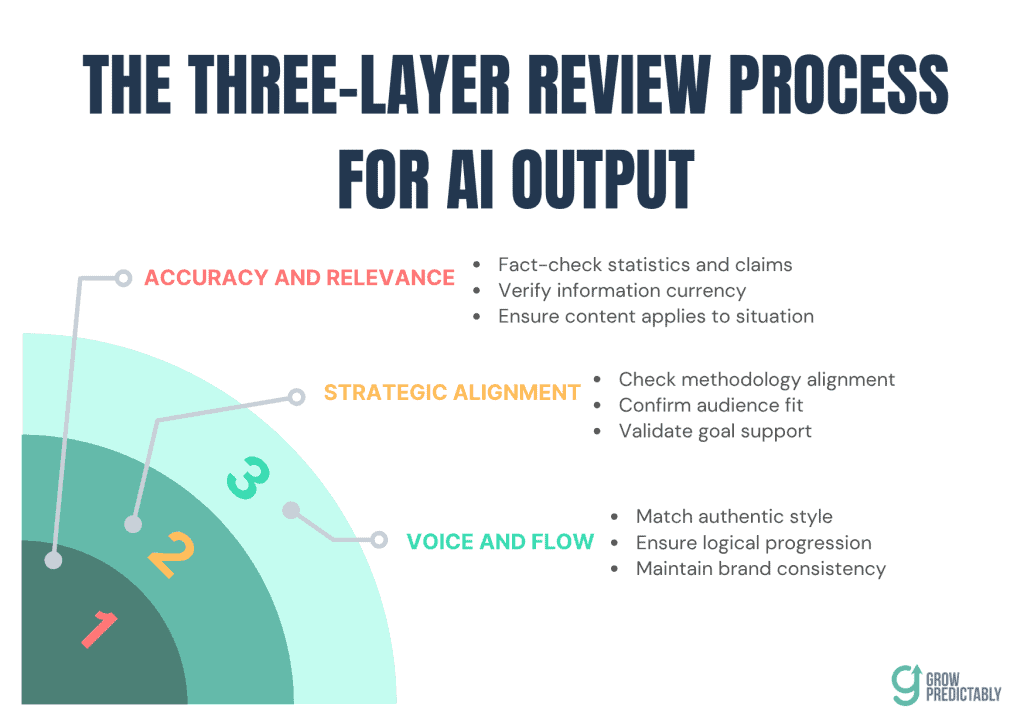
The accuracy review spots factual errors and outdated information.
The strategic review identifies advice that conflicts with your approach or won’t work for your audience.
The voice review ensures the final content maintains your authentic style and personality.
This process takes time but prevents the embarrassing mistakes that happen when you skip human oversight.
Your reputation depends on the quality of everything that carries your name, regardless of which tools helped create it.
The most successful thought leaders use AI to accelerate their work while maintaining complete responsibility for the final output.
They leverage AI’s speed and pattern recognition but never abdicate their role as the expert who ensures quality, relevance, and strategic value.
Myth 6: AI’s Only Value Is in Saving Time or Automating Content
Most thought leaders see AI as a glorified content generator – something to churn out blog posts faster or automate social media responses.
This narrow view misses AI’s real strategic value and reduces it to an expensive typing assistant.
The productivity obsession makes sense because time savings are easy to measure.
You can track how AI cuts your writing time from three hours to thirty minutes.
But focusing only on speed blinds you to opportunities that could transform how you understand your market, clients, and industry.
Smart leaders use AI as an analytical partner, not just a content machine. AI leverages data analysis to generate insights and optimize processes across various business functions.
The technology excels at finding patterns in large datasets, analyzing trends across multiple sources, and connecting dots that human brains might miss when processing information manually.
Effective ai deployment is an iterative process that involves integrating data sources and requires ongoing human oversight to ensure optimal results.
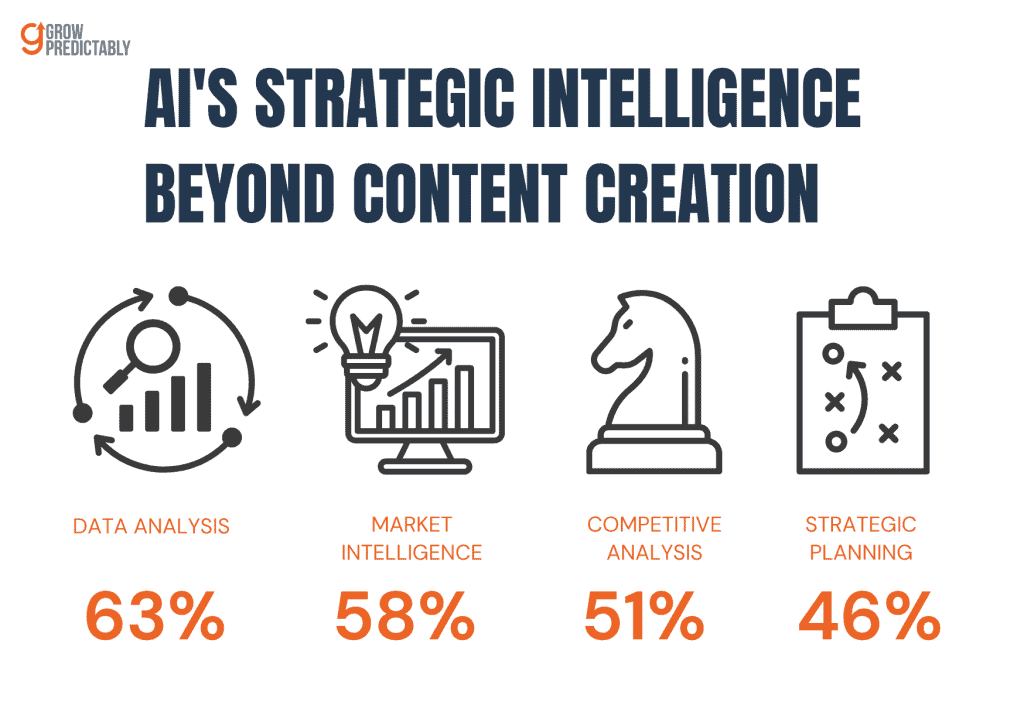
Strategic intelligence you couldn’t access before
AI can analyze thousands of client conversations, competitor content pieces, or industry reports in minutes.
This processing power lets you spot trends and patterns that would take weeks of manual research to uncover.
Your competitive advantage comes from insights, not just efficiency.
When you understand what language resonates with your target audience, which problems are emerging in your industry, or how your messaging compares to competitors, you make better strategic decisions.
The analytical capabilities open up possibilities that pure human research cannot match in terms of scale and speed.
You can process customer feedback from multiple channels simultaneously, identify common pain points across different client segments, or track how market conversations evolve over time.
Consider these strategic applications that go far beyond content creation:
- Analyzing client language patterns to refine your messaging and positioning
- Identifying emerging trends by processing thousands of industry discussions
- Spotting gaps in competitor content that represent market opportunities
- Understanding which topics generate the most engagement across different platforms
- Recognizing shifts in customer priorities before they become obvious
- Finding connections between seemingly unrelated market developments
These insights inform strategy, positioning, and business development in ways that simple content automation never could.
The client language goldmine
Here’s how this works practically.
You feed AI transcripts from your last fifty client calls, asking it to identify the specific words and phrases clients use when describing their biggest challenges.
The AI analysis reveals that clients rarely say “I need better systems” – they say “everything feels chaotic” or “I’m drowning in daily fires.”
This insight transforms your marketing messages from feature-focused to emotion-focused language that actually resonates.
You discover that successful clients use different language patterns than struggling ones.
Successful clients talk about “building sustainable growth” while struggling clients focus on “fixing immediate problems.”
This pattern helps you identify client readiness and customize your approach accordingly.
The language analysis also reveals blind spots in your current messaging.
You think you’re addressing their main concerns, but the data shows clients worry about issues you barely mention.
This intelligence helps you realign your content strategy with actual client needs rather than assumptions.
Studies indicate that businesses using AI for market intelligence show 23% better performance in strategic decision-making compared to those using it only for automation.
Pattern recognition that drives strategy
AI excels at connecting information across different contexts in ways that reveal strategic opportunities.
It might notice that clients who mention specific challenges during initial calls are more likely to invest in premium services, or that certain industries show consistent blind spots you could address.
These patterns inform everything from service development to pricing strategy.
When you understand which client characteristics predict success, you can focus your marketing on attracting more ideal prospects.
When you spot industry-wide gaps, you can develop solutions that meet emerging needs.
The key is asking AI the right analytical questions rather than just requesting content output.
Instead of “write a blog post about leadership,” try “analyze these client conversations to identify the top three concerns that successful leaders share but struggling leaders ignore.”
This shift from automation to analysis transforms AI from a time-saving tool into a strategic asset that improves decision-making and reveals opportunities you wouldn’t have discovered through traditional research methods.
Myth 7: Adopting AI Diminishes Your Value as an Expert
Thought leaders who avoid AI because they fear looking replaceable have it backwards.
The experts who embrace new tools early demonstrate the same forward-thinking mindset that made them successful in the first place.
Embracing new technologies, such as AI, digital art tools, and self-publishing platforms, is transforming the creative and business landscape, driving innovation and adaptability.
The digital world is creating new opportunities for creative and business growth, enabling individuals and organizations to experiment, learn, and thrive in ways that were not possible before.
Your clients hire you for judgment, strategy, and results – not because you type every word yourself.
When you use AI effectively, you show that you understand how to leverage resources intelligently.
This positions you as someone who stays ahead of industry changes rather than someone who gets left behind.
AI is transforming not just the tech industry but every sector, making every business part of the ai industry through innovative use cases.
To stay competitive, organizations should implement AI and integrate it into their operations, ensuring they leverage its benefits for ongoing innovation.
The gap between believers and adapters gets bigger every day. AI enables thought leaders to push boundaries, challenge conventional approaches, and experiment with new ideas to achieve breakthroughs.
The leaders who resist AI aren’t protecting their value – they’re broadcasting that they’re stuck in old ways of thinking.
Meanwhile, their competitors are using AI to deliver better insights faster, freeing up time for the high-value activities that actually differentiate experts.
AI is freeing humans from routine tasks, allowing them to focus on more creative, strategic, and leadership roles. Clients pay premium rates for strategic thinking, not data entry.
Small businesses are also leveraging AI to gain competitive advantages, showing that AI is not just for large enterprises. Even small organizations can afford AI thanks to cost-effective solutions, open-source tools, and accessible cloud platforms.
Higher-level work becomes your focus
AI handles the grunt work so you can focus on what humans do best – building relationships, providing strategic guidance, and making complex decisions.
When you’re not spending hours on research and content creation, you can dedicate more time to understanding your clients’ deeper challenges.
This shift elevates your entire business model.
Instead of selling your time, you sell your insights and transformation. Instead of competing on speed, you compete on wisdom and results.
The AI handles information processing while you handle problem-solving and relationship building.
Your expertise becomes more valuable, not less, because you’re applying it to higher-stakes decisions rather than routine tasks.
Clients pay premium rates for strategic thinking, not data entry.
When AI removes the low-value work from your plate, everything that remains commands higher prices.
The value hierarchy shifts in your favor across multiple areas:
- AI processes information while you synthesize insights into actionable strategies
- AI drafts initial content while you add personal stories and unique perspectives
- AI handles routine research while you focus on complex client conversations
- AI organizes data while you identify patterns that drive business decisions
- AI manages administrative tasks while you build deeper client relationships
- AI supports content creation while you develop innovative methodologies
This division of labor amplifies your expertise rather than replacing it.
Leading your industry’s AI evolution
Smart experts don’t just use AI – they model how to use it responsibly and effectively.
This leadership position becomes a competitive advantage as others in your field struggle with AI adoption.
You become the go-to resource for peers who want to understand how AI fits into professional services.
Speaking opportunities, partnerships, and media coverage follow naturally when you’re recognized as someone who successfully integrated AI without losing authenticity.
Your thought leadership expands beyond your core expertise to include the intersection of technology and human insight.
This positions you at the forefront of industry evolution rather than as someone trying to preserve outdated methods.
Research from Harvard Business Review shows that 71% of executives view AI adoption as a critical leadership competency, with early adopters gaining significant competitive advantages.
Responsible AI use sets the standard
Your approach to AI becomes a model for ethical and effective implementation.
You demonstrate how to maintain quality while leveraging automation, how to preserve authenticity while using AI assistance, and how to enhance rather than replace human expertise.
This modeling attracts clients who want to work with forward-thinking professionals.
They see that you’re not afraid of change but smart about how you implement it.
Your AI integration becomes proof of your strategic thinking and adaptability.
You also set boundaries that protect both your reputation and your industry’s standards.
You show when to use AI and when human judgment is non-negotiable.
You demonstrate transparency about AI assistance without undermining confidence in your expertise.
The combination of embracing innovation while maintaining ethical standards positions you as both progressive and trustworthy – exactly the combination that premium clients seek.
The expertise amplification effect
The most successful thought leaders treat AI as an expertise amplifier rather than a threat.
They use it to research deeper, analyze faster, and serve clients more comprehensively than ever before.
Your value as an expert doesn’t diminish when you use better tools – it compounds.
You can take on more complex projects, serve clients at a higher level, and apply your expertise to bigger challenges.
The AI handles the mechanical work while you focus on the strategic and relational elements that no technology can replicate.
This approach transforms your practice from a time-based service to an insight-based solution.
Clients pay for your judgment, experience, and ability to guide them through complex decisions.
AI helps you deliver these outcomes more effectively, but the outcomes themselves remain uniquely human.
The experts who thrive in an AI-enabled world are those who embrace the technology while doubling down on the distinctly human capabilities that create lasting value.
They become more valuable, not less, because they can deliver better results with greater efficiency.
FAQs
The Future of AI
Looking ahead, the future of AI is bright with possibility.
Technological innovation is set to reshape the business world, with advancements in natural language processing, computer vision, and predictive analytics opening new doors for creative problem solving and strategic growth.
AI will become an integral part of the creative process, helping businesses generate fresh ideas, enhance marketing materials, and develop innovative products and services.
However, realizing this potential requires more than just adopting new tools—it demands a willingness to embrace AI, invest in training, and challenge persistent AI myths.
By developing a deep understanding of how AI works and where it adds real value, organizations can unlock a competitive edge and drive meaningful innovation.
It’s important to remember: AI is a tool, not a replacement for human ingenuity.
The most successful businesses will be those that blend the analytical power of AI with the creativity, empathy, and strategic thinking that only humans can provide.
By working together, humans and AI can create a future where technology enhances our abilities, sparks creativity, and helps us build a better world.
The next chapter of innovation belongs to those who are ready to embrace AI and push the boundaries of what’s possible.
Ready to Lead the Change?
As we’ve explored, AI creativity in thought leadership is less about replacing your spark and more about amplifying your reach, authenticity, and impact.
By debunking myths, leveraging science-backed insights, and integrating practical AI tools, you gain precious time to focus on what only you can do—connect with hearts and minds through genuine stories and wisdom.
Remember: your audience seeks your unique human touch, not just scalable content.
Embrace this opportunity to experiment—test one AI tool in a low-stakes area of your workflow this week, and reflect on the results.
We recommend revisiting industry resources like OpenAI’s Custom Instruction templates or Coachvox’s Voice Calibration tools to deepen your practice.
How might you redefine your creative workflow to give more space to your irreplaceable insights?
Are you ready to lead ethically and authentically in an AI-powered world?
The future belongs to thought leaders who integrate technology without sacrificing the soul of their message—make sure you’re one of them.
In these final thoughts AI, consider how AI can enhance your creativity and leadership while encouraging responsible and thoughtful integration.
Share your experiences below or in your professional network, and don’t forget to explore the resource links provided for your continued growth.


